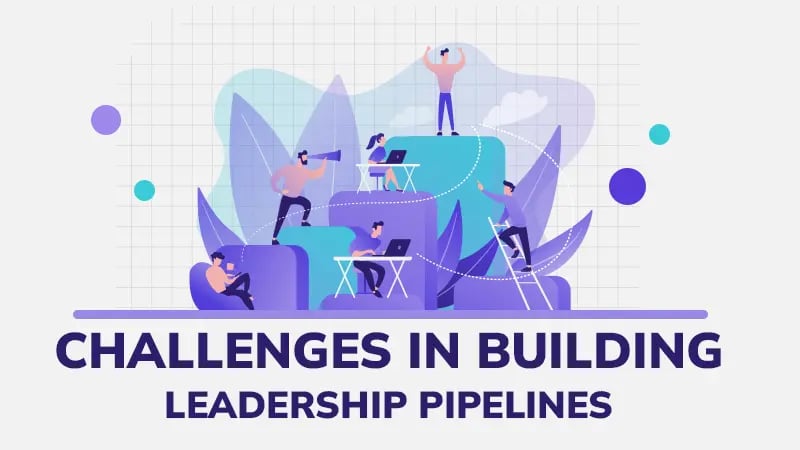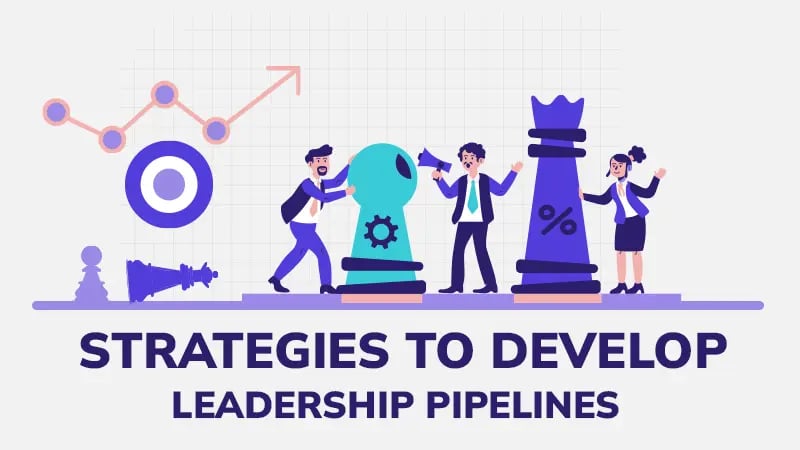A leadership pipeline is a structured approach to developing and nurturing future leaders within an organization. It involves identifying and grooming talented individuals who have the potential to take on leadership roles in the future. With the rapidly changing business landscape, organizations need to have a strong leadership development pipeline to ensure a smooth succession of leaders.
According to Leadership Statistics by Apollotechnical, by 2024, it is estimated that over 70% of organizations in the US will face a leadership crisis as baby boomers retire and the demand for leaders increases. This makes it crucial for organizations to proactively build a leadership pipeline to fill these skill gaps and ensure the continuity of their operations.
Why Building a Leadership Pipeline is Crucial for Organizations?
Building a leadership succession plan is crucial for organizations for several reasons.
Ensuring Continuity
Firstly, it ensures a steady supply of qualified leaders who can effectively guide and drive the organization toward its goals. Without a strong pipeline, organizations may struggle to find suitable leaders when the need arises.
Fostering Growth
A leadership succession pipeline allows for the development and growth of employees within the organization. By providing opportunities for advancement and growth, organizations can retain talented individuals and foster a culture of continuous learning and development.
Navigating Uncertainty
Organizations can better adapt to change and deal with unpredictable times when they have a leadership pipeline in place. Organizations may ensure their long-term success by promptly responding to challenges and seizing opportunities when they have a pool of skilled executives in place.
Obstacles in Creating Effective Leadership Pipelines
Creating effective leadership pipelines to identify good leaders can be challenging for organizations.

Some common challenges include:
Identifying and assessing potential leaders
One challenge in creating talent pipelines is accurately identifying individuals with future leadership potential. While some excel in technical skills, finding those with a blend of interpersonal skills, emotional intelligence, and strategic thinking can be tough. This demands a deep understanding of leadership competencies and objective assessment criteria.
Developing a comprehensive development program
Designing and implementing a personalized learning plan that addresses the specific needs of potential leaders is another significant challenge. Developing future leaders requires more than just providing generic training programs; it requires a tailored approach that addresses the unique strengths, weaknesses, and developmental needs of each individual.
Conquering resistance to change
Establishing leadership pipelines may encounter employee resistance to change, as some fear it threatens their growth opportunities or increases internal competition. They may perceive leadership development plans as jeopardizing their advancement prospects. Concerns arise that identifying high-potential individuals could limit opportunities or intensify organizational competition.
Overcoming these challenges requires a strategic and proactive approach, along with the support and commitment of top leadership.
Implementation Strategies to Develop a Leadership Pipeline Within an Organization
To develop a leadership succession plan within an organization, several strategies can be employed:

Identify and nurture high-potential employees
To build a succession plan for future leaders, identify high-potential employees based on performance, potential, and alignment with organizational values. Provide targeted development opportunities and mentorship to nurture their leadership capabilities.
Provide leadership training and development programs
Investing in tailored leadership training programs equips potential leaders with precise training to address their shortcomings and prepare them for multifaceted responsibilities. These programs cover topics such as communication skills, strategic thinking, decision-making, conflict resolution, and emotional intelligence, enhancing leadership capabilities and preparing individuals to lead teams and drive organizational success.
Create a culture of continuous learning and development
Cultivating a culture of continuous learning and development is essential for developing leadership talent within an organization. Encouraging employees to engage in ongoing learning opportunities, such as workshops, seminars, online courses, and peer-to-peer learning sessions, can help instill a mindset of growth and improvement.
Assessment Tips for Measuring the Impact of Leadership Pipelines
Measuring the impact of the Management succession plan is essential to assess the effectiveness of the development programs and make necessary improvements. Some tips for measuring the impact include:
Setting clear performance metrics
To effectively evaluate the success of the leadership pipeline, it's crucial to establish clear and measurable performance metrics, such as key performance indicators (KPIs), leadership competencies, and milestones, directly aligned with the pipeline's goals. Regularly tracking and analyzing progress against these metrics allows organizations to identify areas for improvement and make data-driven decisions to optimize pipeline effectiveness. Managers can enhance team performance by utilizing a comprehensive dashboard to track real-time key performance indicator (KPI) metrics and identify areas for targeted coaching and interventions.
Conducting 360-degree feedback assessments
Feedback is an invaluable tool for assessing leadership skills and competencies, and 360-degree assessment feedback provides a comprehensive and multi-dimensional view of an individual's performance. By soliciting feedback from peers, subordinates, and supervisors, organizations can gain insights into the strengths, weaknesses, and areas for the development of potential leaders. This holistic feedback helps individuals gain a better understanding of their leadership style and behaviors, enabling them to identify areas for improvement and take actionable steps toward growth.
Monitoring career progression
Tracking the career progression of individuals who have gone through the leadership pipeline is essential for evaluating its long-term impact and effectiveness. By leveraging an LXP (Learning Experience Platform), organizations create a dynamic learning environment supporting continuous growth. Monitoring past participants' career paths helps assess their advancement into leadership roles and the utilization of skills gained. Tracking career progression offers insights into the ROI of the pipeline, demonstrating its impact on organizational succession planning and talent development.
Analyzing employee engagement and retention
Employee engagement and retention are vital indicators of organizational health and culture, also serving as metrics for assessing the leadership development pathway's effectiveness. Measuring engagement and retention rates among pipeline participants allows organizations to gauge its impact on employee satisfaction and commitment. High levels of engagement and retention indicate effective talent nurturing, fostering a positive employee experience, and promoting growth. For instance, with AI-powered skilling solutions like Disprz, a pharmacy retail chain enhanced leadership pipeline effectiveness through KPI-based coaching and microlearning to keep employees updated on industry trends.
Offering Actionable Advice for Organizations Embarking on Their Leadership Pipeline Journey
Building a leadership pipeline is a strategic imperative for organizations looking to thrive in a rapidly evolving landscape. By investing in the development of next-line leaders, companies can future-proof their leadership teams, drive innovation, and sustain long-term growth. Remember, building a leadership succession pipeline is not a one-time effort but a continuous journey that requires dedication, adaptability, and a relentless focus on talent development. As you embark on this journey, keep your sights set on building a pipeline of future leaders who will carry your organization forward with confidence and resilience.
In the pursuit of excellence, building a leadership pipeline remains an indispensable endeavor, ensuring that organizations are equipped with the visionary leaders needed to navigate the complexities of the modern business world. By leveraging the comprehensive features of Disprz LXP solutions, modern organizations can transform their learning and development programs, enhance talent management, and stay ahead of the competition. With capabilities ranging from skill dictionaries to skills-based career progression, organizations can create a culture of leadership excellence that drives sustained success for years to come.








